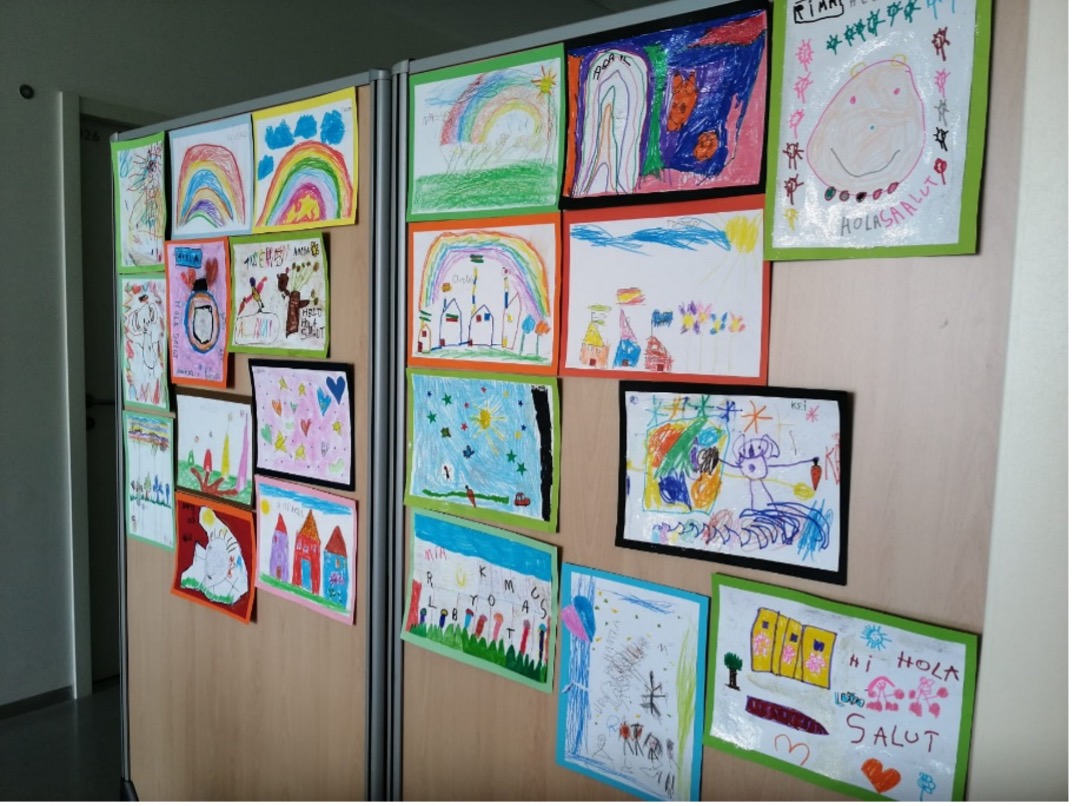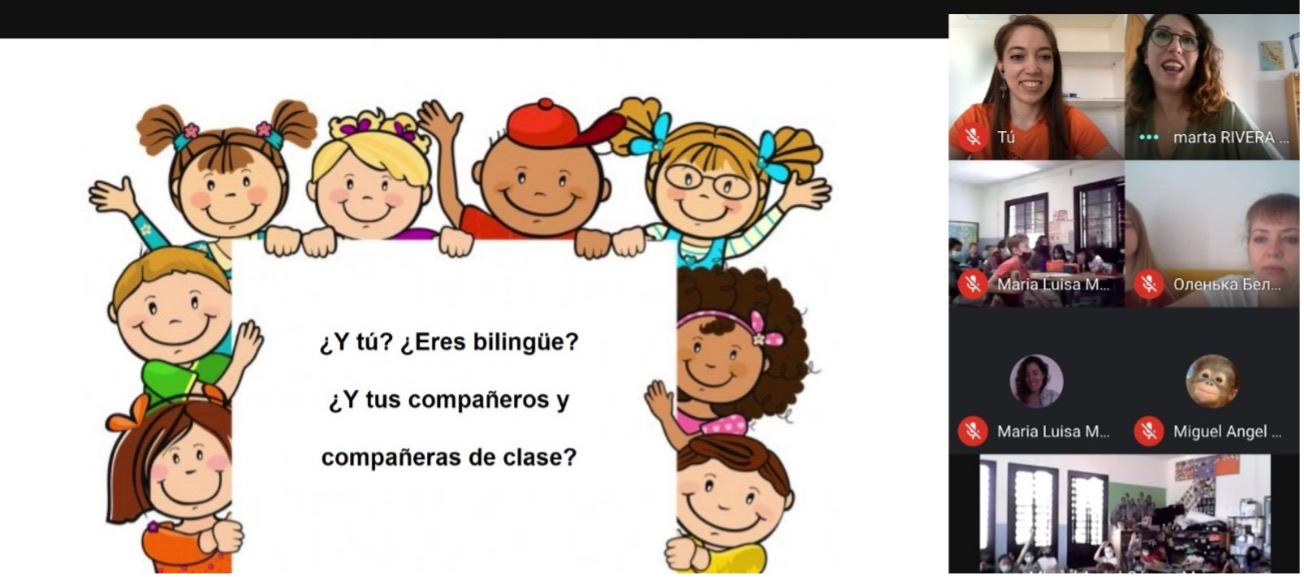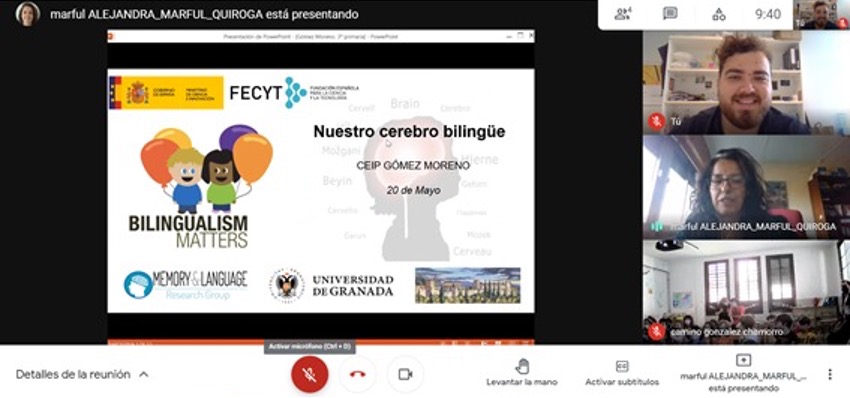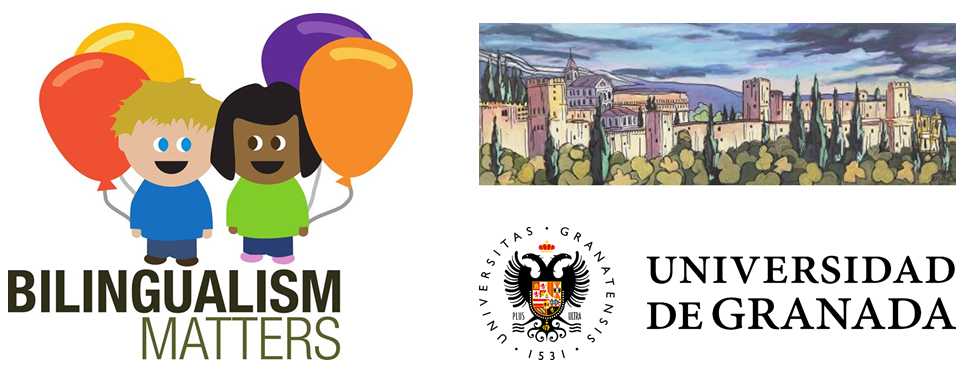
El día 20 de mayo, varios miembros del equipo de Bilingualism Matters Ugr (Alejandra Marful, Antonio Iniesta, Melodie Bellegarda, Marta Rivera, Marta Reyes y Cristina López-Rojas) visitaron de forma online el colegio Gómez Moreno. Este colegio se encuentra localizado en el antiguo barrio del Albaicín y es especialmente relevante dentro del proyecto, debido a la multiculturalidad que hay en sus aulas. Posiblemente sea uno de los coles de Granada con más niños y niñas bilingües o multilingües, y en el que confluyen mas nacionalidades diferentes.
On the 20th of may, several of our BM Ugr team members (Alejandra Marful, Antonio Iniesta, Melodie Bellegarda, Marta Rivera, Marta Reyes and Cristina López-Rojas) paid a virtual visit to Gómez Moreno Elementary School. This elementary school is located in the historic Albaicín neighborhood and is especially relevant to our project due the multiculturality of the students who walk its halls. It is possibly one of the elementary schools in Granada with the most bilingual and multilingual children. In addition, this elementary school brings together many different nationalities.
Durante nuestras charlas hablamos con los alumnos y las alumnas de 1º, 3º y 6º de primaria, sobre el método científico, la importancia de todos los idiomas dentro del espectro bilingüe, y sobre que es el bilingüismo y las falsas creencias que existen sobre que es una persona bilingüe. Además, pudimos hacer algunas demostraciones de los experimentos que realizamos en el laboratorio donde se evidencian ciertos mecanismo y fenómenos bilingües, como son la coactivación y el coste de cambio. No olvidamos el objetivo transversal del proyecto, en el resaltamos la importancia de la mujer y la niña en la ciencia. Por último, pudieron ver las técnicas de registro cerebral que usamos en neurociencia, mediante videos, y ejemplos en directo de su uso, concretamente de la electroencefalografía (EEG), y la resonancia magnética funcional (fMRI).
La clase de los mas pequeños, escucharon un divertido cuento, en varios idiomas (español, inglés y árabe) para resaltar la idea de que todos los idiomas son importantes, y que todos reorganizan y re-estructuran el cerebro de las personas que los conocen. Al final se estableció un enriquecedor turno de preguntas, y de debate, que fue muy fructífero a pesar de ser online, y surgieron preguntas muy interesantes sobre el funcionamiento del cerebro o de cómo llegar a ser científicos.
We gave talks to 1st grade, 3rd grade and 6th grade students, and our topics of focus were the scientific method, “what is bilingualism?”, the importance of all languages within the bilingual spectrum, and the truths and myths about bilinguals. In addition, we were able to do some experiment demos that we usually do in our laboratory, which showed the students some bilingual mechanisms and phenomenons, such as language co-activation and switching costs. We didn’t forget our project’s transversal objective in which we highlight the importance of women and girls in science. Finally, the students were able to see some of the techniques we use in our laboratory through videos about magnetic resonance and EEG and well as a live demo with an EEG cap.
The class with the younger students listened to a fun story in various languages (Spanish, English, and Arabic) to emphasize the importance of all languages and explain how languages reorganize and restructure the brain of people they know. At the end of the session, we knew we had established a strong and enriching connection with the students because they were very active in a round of questions and a debate. We received many interesting questions about how the brain works and how to become a scientist.
Como agradecimiento, y para contribuir con la labor de divulgación, todos los niños y niñas de las clases recibieron un obsequio. Se trató de un boli con luces, o de cuatro colores con el mensaje de #yosoybilingue.
As a thank you and to help with our dissemination purpose, all the boys and girls received a little gift. We gave them a light up pen and a pen with four different ink colors with a message printed on the side #iambilingual
Al acabar la sesión en la clase de 1º de primaria se propuso un certamen de dibujos que representasen la charla que habíamos impartido, para poder colocarlos en nuestros laboratorios y poder ponerlos en nuestras redes sociales. Hubo una participación extraordinaria. Todos los dibujos ahora forman un mural de nuestro laboratorio, e hicimos llegar esa foto al cole. Ahora los niños y niñas del Gómez Moreno forman parte de nuestro laboratorio. Para los alumnos de 3º y 5º se propuso un certamen de cuentos. Tendrían dos semanas para escribir un relato titulado “la ciudad de los idiomas”. Ante una importante participación del alumnado, nos reunimos para seleccionar los 3 mejores de cada clase. Los ganadores recibieron un detalle extra por su ingenio y trabajo, que constaba de una libreta y un estuche de BM-UGR.
After the session, we challenged the 1st graders to a drawing competition where they had to represent the talk we gave them with a drawing. We wanted these drawings to decorate our laboratory and disseminate on social media. There was lots of enthusiasm and participation. With the drawings we received, we’ve created a mural in our laboratory, so now the students from Gómez Moreno form part of our lab! The 3rd and 5th graders participated in a writing competition, where they had to write a short story about “The city of languages”. We selected the 3 best stories for each class and the winners were awarded prizes for their creative work: a notebook with a pencil-case from Bilingualism Matters Ugr.
Fue un día precioso y fue muy emocionante poder llevar la ciencia a personas que están en el camino de decidir su futuro, y poder despertar en ellos una curiosidad por los idiomas o la investigación. Difícilmente olvidaremos todas las sensaciones y experiencias vividas, y esperamos haber sembrado esa “semilla científica” en niños y niñas.
It was a beautiful day and it was exciting to be able to bring science to young people who are the future of the world, and be able to awaken in them curiosity for languages and research. We won’t forget this experience and we hope that we have planted a scientific seed in the boys and girls from this school.



